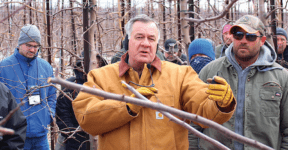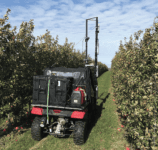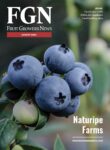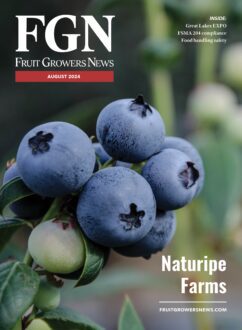Dec 21, 2020$4.8M multi-state effort aims for easier bud-counting
For years, Cornell University’s Terence Robinson has advised growers to count buds on their apple trees and prune with a specific number of buds in mind.
His pitch goes like this: Growers can increase revenue by getting the right number of apples and the amount of foliage on the tree that lead to high-grade apples. So, he encourages growers to count buds on trees that best represent a few acres of orchard and dial in their pruning accordingly.

But even Robinson admits that growers who follow that advice are the exception rather than the rule in the industry. “I really pushed hard and got a few growers to count (buds on) trees in the winter, blossom and hand-thinning time,” Robinson said. “There are a couple of growers in the state (New York) who religiously do that. I think there’s a couple in Washington, there may be a couple in Michigan, I’m not sure,” Robinson said. “It just seemed like people would do it for a while, but it seemed too cumbersome.”
However, a new research effort is aimed at making bud-counting and precision pruning easier, and better-informed. A four-year, $4.8 million grant from the USDA’s National Institute of Food and Agriculture will enable Robinson and colleagues around the country to look at the economics and equipment of the pruning as well as refine their scientific models for pruning individual varieties in different states.
A grower testimonial
Robinson said he first “finalized” his thinking on precision crop load management in a 2013 presentation in Geneva, New York, for Eastern apple growers.
“Generally, Gala growers in New York will get between eight to ten thousand (dollars) back per acre, if they have a high yield. The cost of production is about $7,500. So, there’s a profit, there,” he said. “But if everything was perfect – if everything was of a premium size and yield, the return could be $15,000 per acre. There’s quite a bit of potential that’s never realized. What I’m looking to do is move the economic needle for growers, and that comes from changing the value of the crop – value-added rather than value-subtracted.”
A sort of case study for a grower who embraced that model is Rod Farrow, the recent past president of the International Fruit Tree Association, who recently sold his stake in Lamont Fruit farm to partners Jose Iniguez and Jason Woodworth.
“We’ve been very dedicated to (bud-counting), and we went through several iterations of it,” Farrow said. Farrow once had invested in a separate, now-unused, expensive machine to count apples in an orchard. Today, Iniguez and a small crew still count buds before pruning.
Farrow said precision pruning has to be driven by solid data.
“If you don’t know if you want 60 or 80 apples on a tree, or 100 or 130, you’re kind of in trouble before you get started,” he said. “Part of it’s history, too – knowing what you can and cannot do. Like we’re sure – we’ve had to perfect it – but we’re sure we can have close to 100 apples on Galas if we can finish thinning during bloom – another 65 apples if we finish thinning at 18 millimeters and then with hand-thinning. … but all of this comes down to what are your numbers (and) when.”

Technical expertise
The goal for Robinson has always been to incorporate technology and automation in a way to make the process easier.
In 2018, he began collaborating with Moog Inc., a western New York-based aerospace and defense company with a growing digital agriculture branch. He said the company previously worked in California almond orchards.
The goal would be a Moog autonomous vehicle that rolls through orchards to count buds and estimate tree diameter with a vision system. The goal would be to store and process the information in a cloud-based computer system and provide pruning suggestions to a grower via a phone, headset or helmet.
“There’s a period of time between green tip and bloom … when we think counting can be most accurate and there are few leaves to occlude fruit,” Robinson said. “And we think that information will allow the grower to make adjustments in pruning and thinning – and especially at thinning time – to end up with exact numbers of fruits on that tree.”
Eventually – in an age where automated harvesting is being explored – a system for automated pruning may be incorporated into the project, Robinson said.
Multi-state research
Pruning practices can vary greatly by apple tree cultivar and the growing region, so colleagues across the country will work to develop numbers for those particulars.
“For example, with Honeycrisp, if you hang too many apples on the tree, and you possibly can get away with it that year and still have decent quality but you end up with no bloom the next year,” Robinson said.
“And for Galas, it seems to me, without having any hard data, that (Washington growers) can hang more Galas on the tree and still get more 80-count (sized) apples than we can in New York because they have more sunshine and better temperatures.
States will also track varieties tied to their growers, for instance, Cosmic Crisp in Washington and SnapDragon in New York. But Galas – the country’s top apple in terms of sales volume – will be a constant throughout experiments in the different states.
“They all will have Gala – that will give us a cross-climate comparison,” Robinson said.
Colleagues in collaboration
Cornell University’s Terence Robinson works with horticulturalists, engineers and economists around the country to research precision crop load management.
The research team includes:
Washington State University
- Stefano Musacchi
- Karen Lewis (Extension)
Michigan State University
- Todd Einhorn
- Phil Schwallier (Extension)
Cornell University
- Terence Robinson
- Lailiang Cheng
- Greg Peck
- Mario Miranda Sazo (Extension)
- Craig Kahlke (Extension)
- Yun Jiang (engineering)
- Miguel Gomez (economics)
Penn State University
- Paul Heinemann
- Daeun Dana Choi
- Long He (engineering)
North Carolina State University
- Thomas M. Kon
Virgina Tech
- Sharif Sharif
University of Massachusetts
- Jon Clements (Extension)
Moog Inc.
- Chris Layer (engineering)
Consultant
- Rod Farrow (grower)
— Stephen Kloosterman, associate editor














